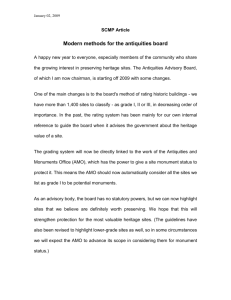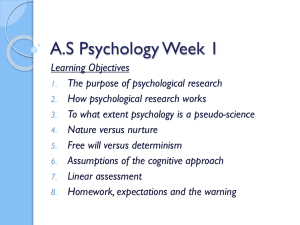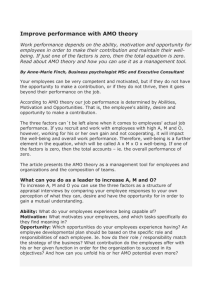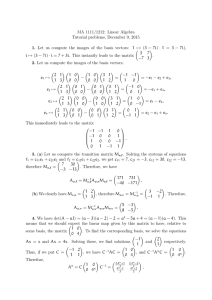Deterministic model derivation and model reduction of an activator-repressor genetic oscillator Introduction
advertisement
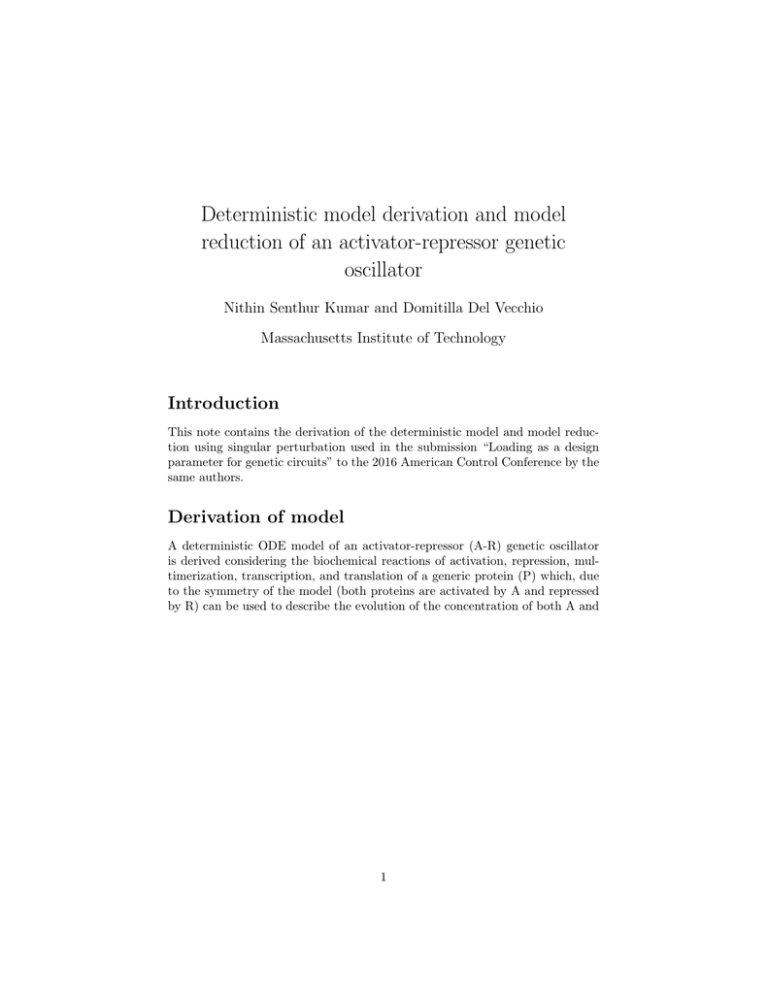
Deterministic model derivation and model reduction of an activator-repressor genetic oscillator Nithin Senthur Kumar and Domitilla Del Vecchio Massachusetts Institute of Technology Introduction This note contains the derivation of the deterministic model and model reduction using singular perturbation used in the submission “Loading as a design parameter for genetic circuits” to the 2016 American Control Conference by the same authors. Derivation of model A deterministic ODE model of an activator-repressor (A-R) genetic oscillator is derived considering the biochemical reactions of activation, repression, multimerization, transcription, and translation of a generic protein (P) which, due to the symmetry of the model (both proteins are activated by A and repressed by R) can be used to describe the evolution of the concentration of both A and 1 R. These reactions are given by: βA −* A + A + ... + A − ) −− An , (1) β A0 βR −−* R + R + ... + R ) −− Rm , (2) β R0 a∗ P − * Rm + DNAP − ) − − Rm : DNA , ∗ (3) d a0 P −− * An + DNAP ) − − An : DNA , 0 (4) d α An : DNAP −−1→ mP + An : DNAP , P α2 P DNA −−→ mP + DNA , κ mP −−→ mP + P, δ mP −−→ ∅, γ P −−→ ∅. (5) (6) (7) (8) (9) Let A and R multimerize with cooperativity n and m, with forward rates of 0 0 , respectively, leading to reactions (1)-(2). , βR βA , βR and reverse rates of βA Since activation and repression are assumed to take place at the transcriptional level, the complex formed by the reversible reaction (with forward rate a∗ and reverse rate d∗ ) between Rm and DNA promoter (DNAP ), denoted Rm :DNAP , does not contribute to transcription and effectively sequesters free DNAP , as given in (3). Conversely, An :DNAP is the complex formed by the reversible reaction (with forward rate a0 and reverse rate d0 ) between An and DNAP , as shown in (4). This complex undergoes translation at rate α1 to produce an mRNA molecule, leading to (5). The model also assumes that some transcription can occur without A bound to DNAP (i.e., transcriptional leakiness), described by (6). Translation occurs at a rate κ, given in (7), and mRNA and protein decay at a rate δ and γ, respectively, given in (8)-(9). The ODE model for the mRNA and protein dynamics is given by: ṁP = α1 [An : DN AP ] + α2 [DN AP ] − δmP , Ṗ = κmP − γP. (10) Assuming the total concentration of DNA is constant, the following conservation law holds: DN Atot = DN AP + [Rm : DN AP ] + [An : DN AP ]. Assuming complex formation occurs significantly faster than mRNA and protein dynamics [1], setting their respective rate equations at quasi-steady state (i.e., ˙ ˙ P ], [R : DNA P ]= 0) and solving for [A :DNAP ] and [DNAP ] Ȧn , Ṙm , [An : DNA m n 2 in terms of A, R yields: P [An : DNA ] = [DNAP ] = 1+ 1+ a0 βA n d0 βA0 DN Atot A , a0 βA n a∗ βR m d0 βA0 A + d∗ βR0 R (11) DN Atot . ∗ An + da∗ ββR0 Rm (12) a0 βA d0 βA0 R Equation (10) represents the dynamics of a general mRNA and protein system with transcriptional activation and repression by A and R, respectively. Substituting (11)-(12) in (10) and then using the subscripts “R” or “A” to denote parameters corresponding to R or A production and decay, respectively yields the final model equations: α(A/kA )n + α0 − δA mA , 1 + (A/kA )n + (R/kR )m α(A/kA )n + α0 ṁR = − δR mR , 1 + (A/kA )n + (R/kR )m ṁA = Ȧ = κA mA − γA A, Ṙ = κR mR − γR R. (13) Model reduction via singular perturbation of system with load to A We consider A transcriptionally regulating downstream promoter sites. Let the free promoter sites be denoted as C10 and the sites bound to A be denoted as C11 . Since DNA does not decay, the total concentration of promoter sites is conserved, that is C10 + C11 = Ct1 , where Ct1 represents the total concentration of the free and bound promoter sites. The complex formation reaction is given a by: C10 + A C11 , leading to the three-state system: d κA α(A/kA )n + α0 − γA A − Ċ11 , δA 1 + (A/kA )n + (R/kR )m κR α(A/kA )n + α0 Ṙ = − γR R, δR 1 + (A/kA )n + (R/kR )m Ȧ = Ċ11 = a(Ct1 − C11 )A − dC11 . (14) In order to analyze how the eigenvalues of the linearized system change due to the addition of Ct1 , we consider a reduced order model. Using the assumption that complex formation (C11 ) occurs relatively faster than protein dynamics (A,R) [1], the three-state system can be reduced to two states. To this end, we employ singular perturbation and introduce the new (slow) variable Z, defined γA . as Z = A+C11 . Rewrite the system by defining = γdA , Kd1 = ad , and a = K d1 3 Substituting these expressions into (14) yields the system in standard singular perturbation form given by: Ż = 11 n α( Z−C κA kA ) + α0 − γA (Z − C11 ), 11 n δA 1 + ( Z−C ) + (R/kR )m k A 11 n α( Z−C κR kA ) + α0 Ṙ = − γR R, 11 n m δR 1 + ( Z−C kA ) + (R/kR ) γA Ċ11 = (Ct1 − C11 )(Z − C11 ) − γA C11 . Kd1 (15) Setting = 0 and solving for C11 in terms of A yields the slow manifold: C11 = Ct1 A/Kd1 = g1 (A), 1 + A/Kd1 which can be shown to be locally exponentially stable [2]. Since Z = A + C11 , we have Ż = Ȧ + Ċ11 , and so: Ż = Ȧ + dg1 (A) Ȧ. dA Solving for Ȧ yields: Ż Ȧ = = 1+ κ A dg1 (A) dA , α( kAA )n + α0 δA 1 + ( kA )n + ( kR )m A R − γA A A 2 Kd1 ) Ct1 A 2 Kd1 ) + Kd1 (1 + (1 + . The resulting reduced model of the clock with load on A is thus given by: ! (1 + KAd1 )2 α( kAA )n + α0 κA Ȧ = − γA A , Ct1 δA 1 + ( kA )n + ( kR )m (1 + KAd1 )2 + K A R d1 Ṙ = κR α(A/kA )n + α0 − γR R. δR 1 + (A/kA )n + (R/kR )m Model reduction of the system with load on R can be similarly derived. Model reduction via singular perturbation of system with load and complex decay We consider load to A transcriptionally regulating downstream promoter sites that decay at a constant rate when bound with A. The modified load reactions to A are given by: a A + C10 C11 , d πA C11 → C10 . 4 The dynamics of the three-state system have changed to (f1 (A, R) = f2 (A, R) = α(A/kA )n +α0 κR δR 1+(A/kA )n +(R/kR )m ): α(A/kA )n +α0 κA δA 1+(A/kA )n +(R/kR )m , Ȧ = f1 (A, R) − γA A + dC11 − aA(Ct1 − C11 ), Ṙ = f2 (A, R) − γR R, Ċ11 = aA(Ct1 − C11 ) − (d + πA )C11 . Introduce a slow (X) and fast (Y) variable, given by: X = A + C11 , d C11 . Y = d + πA The three-state system is thus now given by (pA = d d+πA ): Y Y πA Y , R) − γA (X − )− , pA pA pA Y Y Y Ẏ = pA a(X − )(Ct1 − )−d , pA pA pA Y Ṙ = f2 (X − , R) − γR R. pA Ẋ = f1 (X − Define = γA d , Kd1 = ad . This leads to d = Ẏ = γA , a= γA Kd1 , and: γA p A Y γA Y A(Ct1 − )− . Kd1 pA Kd1 Set = 0 to find the slow manifold: p2A Y A(Ct1 − ), Kd1 pA p2A Ct1 A = h1 (A). = Kd1 + pA A Y = Solving for Ȧ: X =A+ Y , pA Ẋ = Ȧ + Ẋ 1 ∂h1 Ȧ =⇒ Ȧ = , 1 pA ∂A 1 + p1A ∂h ∂A Ȧ = f1 (A, R) − γA A − 1+ πA pA Ct1 A Kd1 +pA A pA Kd1 Ct1 (Kd1 +pA A)2 . Model reduction of the system with load on R and complex decay can be similarly derived. 5 References [1] U. Alon, “An Introduction to Systems Biology: Design Principles of Biological Circuits,” Chapman & Hall/CRC, 2007. [2] D. del Vecchio and R. Murray, “Biomolecular Feedback Systems,” Princeton University Press, 2014. 6


